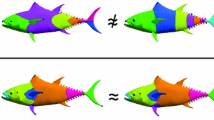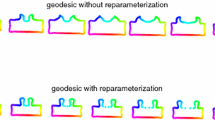Abstract
In this paper, the problem of non-rigid shape recognition is studied from the perspective of metric geometry. In particular, we explore the applicability of diffusion distances within the Gromov-Hausdorff framework. While the traditionally used geodesic distance exploits the shortest path between points on the surface, the diffusion distance averages all paths connecting the points. The diffusion distance constitutes an intrinsic metric which is robust, in particular, to topological changes. Such changes in the form of shortcuts, holes, and missing data may be a result of natural non-rigid deformations as well as acquisition and representation noise due to inaccurate surface construction. The presentation of the proposed framework is complemented with examples demonstrating that in addition to the relatively low complexity involved in the computation of the diffusion distances between surface points, its recognition and matching performances favorably compare to the classical geodesic distances in the presence of topological changes between the non-rigid shapes.
Similar content being viewed by others
References
Belkin, M., & Niyogi, P. (2003). Laplacian eigenmaps for dimensionality reduction and data representation. Neural Computation, 13, 1373–1396.
Belkin, M., Sun, J., & Wang, Y. (2009). Constructing Laplace operator from point clouds in R d. In Proc. SIAM symp. discrete algorithms (pp. 1031–1040).
Besl, P. J. & McKay, N. D. (1992). A method for registration of 3D shapes. IEEE Transactions on Pattern Analysis and Machine Intelligence (PAMI), 14, 239–256.
Bobenko, A. I., & Springborn, B. A. (2007). A discrete Laplace–Beltrami operator for simplicial surfaces. Discrete and Computational Geometry, 38(4), 740–756.
Boutin, M., & Kemper, G. (2004). On reconstructing n-point configurations from the distribution of distances or areas. Advances in Applied Mathematics, 32(4), 709–735.
Bronstein, A. M., Bronstein, M. M., & Kimmel, R. (2005). Three-dimensional face recognition. International Journal of Computer Vision (IJCV), 64(1), 5–30.
Bronstein, A. M., Bronstein, M. M., & Kimmel, R. (2006a). Efficient computation of isometry-invariant distances between surfaces. SIAM Journal on Scientific Computing, 28(5), 1812–1836.
Bronstein, A. M., Bronstein, M. M., & Kimmel, R. (2006b). Generalized multidimensional scaling: a framework for isometry-invariant partial surface matching. Proceedings of the National Academy of Science (PNAS), 103(5), 1168–1172.
Bronstein, A. M., Bronstein, M. M., & Kimmel, R. (2007a). Calculus of non-rigid surfaces for geometry and texture manipulation. IEEE Transactions on Visualization and Computer Graphics, 13(5), 902–913.
Bronstein, A. M., Bronstein, M. M., & Kimmel, R. (2007b). Expression-invariant representation of faces. IEEE Transactions on Image Processing, 16(1), 188–197.
Bronstein, A. M., Bronstein, M. M., & Kimmel, R. (2007c). Rock, paper, and scissors: extrinsic vs. intrinsic similarity of non-rigid shapes. In Proc. int. conf. computer vision (ICCV).
Bronstein, A. M., Bronstein, M. M., & Kimmel, R. (2008). Numerical geometry of nonrigid shapes. Berlin: Springer.
Bronstein, A. M., Bronstein, M. M., & Kimmel, R. (2009). Topology-invariant similarity of nonrigid shapes. International Journal of Computer Vision (IJCV), 81(3), 281–301.
Bronstein, M. M., & Bronstein, A. M. (2009). On a relation between shape recognition algorithms based on distributions of distances (Technical Report CIS-2009-14). Technion.
Burago, D., Burago, Y., & Ivanov, S. (2001). A course in metric geometry. Graduate studies in mathematics, Vol. 33. Providence: AMS.
Chen, Y., & Medioni, G. (1991). Object modeling by registration of multiple range images. In Proc. conf. robotics and automation.
Chung, F. R. K. (1997). Spectral graph theory. Providence: AMS.
Coifman, R. R., & Lafon, S. (2006). Diffusion maps. Applied and Computational Harmonic Analysis, 21, 5–30.
Coifman, R. R., Lafon, S., Lee, A. B., Maggioni, M., Nadler, B., Warner, F., & Zucker, S. W. (2005). Geometric diffusions as a tool for harmonic analysis and structure definition of data: Diffusion maps. Proceedings of the National Academy of Sciences (PNAS), 102(21), 7426–7431.
Cox, T. F., & Cox, M. A. A. (1994). Multidimensional scaling. London: Chapman and Hall.
DoCarmo, M. P. (1992). Riemannian geometry. Boston: Birkhäuser.
Elad, A., & Kimmel, R. (2002). Spherical flattening of the cortex surface. In Geometric methods in bio-medical image processing (Vol. 2191, pp. 77–89). Berlin: Springer.
Elad, A., & Kimmel, R. (2003). On bending invariant signatures for surfaces. IEEE Transactions on Pattern Analysis and Machine Intelligence (PAMI), 25(10), 1285–1295.
Farin, D., de With, P. H. N., Effelsberg, W., & De, P. H. N. (2003). Recognition of user-defined video object models using weighted graph homomorphism. In SPIE IVCP.
Floater, M. S., & Hormann, K. (2005). Surface parameterization: a tutorial and survey. Advances in Multiresolution for Geometric modelling 1.
Gal, R., Shamir, A., & Cohen-Or, D. (2007). Pose-oblivious shape signature. IEEE Transactions on Visualization and Computer Graphics, 13(2), 261–271.
Gromov, M. (1981). Structures métriques pour les variétés riemanniennes. Textes mathématiques, no. 1.
Grossman, R., Kiryati, N., & Kimmel, R. (2002). Computational surface flattening: a voxel-based approach. IEEE Transactions on Pattern Analysis and Machine Intelligence (PAMI), 24(4), 433–441.
Hamza, A. B., & Krim, H. (2005) Probabilistic shape descriptor for triangulated surfaces. In Proc. ICIP (pp. 1041–1044).
Hein, M., Audibert, J.-Y., & von Luxburg, U. (2007). Graph Laplacians and their convergence on random neighborhood graphs. Journal of Machine Learning Research, 8, 1325–1368.
Hochbaum, D. S., & Shmoys, D. B. (1985). A best possible heuristic for the k-center problem. Mathematics of Operations Research, 180–184.
Jain, V., & Zhang, H. (2007). A spectral approach to shape-based retrieval of articulated 3D models. Computer-Aided Design, 39, 398–407.
Jones, P. W., Maggioni, M., & Schul, R. (2008). Manifold parametrizations by eigenfunctions of the Laplacian and heat kernels. Proceedings of the National Academy of Sciences, 105(6), 1803.
Katz, S., Leifman, G., & Tal, A. (2005). Mesh segmentation using feature point and core extraction. The Visual Computer, 21(8), 649–658.
Kimmel, R., & Sethian, J. A. (1998). Computing geodesic paths on manifolds. Proceedings of the National Academy of Sciences (PNAS), 95(15), 8431–8435.
Lafon, S. (2004). Diffusion maps and geometric harmonics. Ph.D. dissertation, Yale University.
Lévy, B. (2006). Laplace-Beltrami eigenfunctions towards an algorithm that “understands” geometry. In Int’l conf. shape modeling and applications.
Ling, H., & Jacobs, D. (2005a). Deformation invariant image matching. In Proc. ICCV.
Ling, H., & Jacobs, D. (2005b). Using the inner-distance for classification of articulated shapes. In Proc. CVPR.
Mahmoudi, M., & Sapiro, G. (2009). Three-dimensional point cloud recognition via distributions of geometric distances. Graphical Models, 71(1), 22–31.
Mateus, D., Horaud, R. P., Knossow, D., Cuzzolin, F., & Boyer, E. (2008). Articulated shape matching using Laplacian eigenfunctions and unsupervised point registration. In Proc. IEEE conference on computer vision and pattern recognition (CVPR).
Mémoli, F. (2007). On the use of Gromov-Hausdorff distances for shape comparison. In Point based graphics, Prague.
Mémoli, F. (2008). Gromov-Hausdorff distances in Euclidean spaces. In Proc. non-rigid shapes and deformable image alignment (NORDIA).
Mémoli, F. (2009). Spectral Gromov-Wasserstein distances for shape matching. In Proc. non-rigid shape analysis and deformable image alignment.
Mémoli, F., & Sapiro, G. (2001). Fast computation of weighted distance functions and geodesics on implicit hyper-surfaces. Journal of Computational Physics, 173(2), 730–764.
Mémoli, F., & Sapiro, G. (2005a). Distance functions and geodesics on submanifolds of R d and point clouds. SIAM Journal of Applied Mathematics, 65, 1227–1260.
Mémoli, F., & Sapiro, G. (2005b). A theoretical and computational framework for isometry invariant recognition of point cloud data. Foundations of Computational Mathematics, 5, 313–346.
Mémoli, F., Sapiro, G., & Thompson, P. (2006). Geometric surface and brain warping via geodesic minimizing Lipschitz extensions. In MFCA-2006 international workshop on mathematical foundations of computational anatomy, Copenhagen.
Meyer, M., Desbrun, M., Schroder, P., & Barr, A. H. (2003). Discrete differential-geometry operators for triangulated 2-manifolds. Visualization and Mathematics, III, 35–57.
Olver, P. (1999). Classical invariant theory. Cambridge: Cambridge University Press.
Osada, R., Funkhouser, T., Chazelle, B., & Dobkin, D. (2002). Shape distributions. ACM Transactions on Graphics (TOG), 21(4), 807–832.
Ovsjanikov, M., Sun, J., & Guibas, L. (2008). Global intrinsic symmetries of shapes. Computer Graphics Forum, 27, 1341–1348.
Ovsjanikov, M., Bronstein, A. M., Bronstein, M. M., & Guibas, L. (2009). Shape Google: a computer vision approach for invariant retrieval of non-rigid shapes. In Proc. non-rigid shape analysis and deformable image alignment.
Qiu, H., & Hancock, E. R. (2007). Clustering and embedding using commute times. IEEE Transactions on Pattern Analysis and Machine Intelligence, 29(11), 1873–1890.
Raviv, D., Bronstein, A. M., Bronstein, M. M., & Kimmel, R. (2007). Symmetries of non-rigid shapes. In Proc. workshop on non-rigid registration and tracking through learning (NRTL).
Reuter, M., Wolter, F.-E., & Peinecke, N. (2006). Laplace-Beltrami spectra as “shape-DNA” of surfaces and solids. Computer Aided Design, 38, 342–366.
Reuter, M., Biasotti, S., Giorgi, D., Patanè, G., & Spagnuolo, M. (2009). Discrete Laplace-Beltrami operators for shape analysis and segmentation. Computers & Graphics, 33, 381–390.
Ruggeri, M. R., & Saupe, D. (2008). Isometry-invariant matching of point set surfaces. In Proc. eurographics 2008 workshop on 3D object retrieval.
Ruggeri, M. R., Patanè, G., Spagnuolo, M., & Saupe, D. (2009). Spectral-driven isometry-invariant matching of 3D shapes. International Journal of Computer Vision.
Rustamov, R. M. (2007). Laplace-Beltrami eigenfunctions for deformation invariant shape representation. In Proc. symp. geometry processing (SGP) (pp. 225–233).
Schwartz, E. L., Shaw, A., & Wolfson, E. (1989). A numerical solution to the generalized mapmaker’s problem: flattening nonconvex polyhedral surfaces. IEEE Transactions on Pattern Analysis and Machine Intelligence (PAMI), 11, 1005–1008.
Singh, G., Mémoli, F., & Carlsson, G. (2007). Topological methods for the analysis of high dimensional data sets and 3d object recognition. In Point based graphics, Prague.
Spira, A., & Kimmel, R. (2004). An efficient solution to the eikonal equation on parametric manifolds. Interfaces and Free Boundaries, 6(3), 315–327.
Sun, J., Ovsjanikov, M., & Guibas, L. (2009). A concise and provably informative multi-scale signature based on heat diffusion. In Proc. symp. geometry processing (SGP).
Tennenbaum, J. B., de Silva, V., & Langford, J. C. (2000). A global geometric framework for nonlinear dimensionality reduction. Science, 290(5500), 2319–2323.
Walter, J., & Ritter, H. (2002). On interactive visualization of high-dimensional data using the hyperbolic plane. In Proc. int’l conf. knowledge discovery and data mining (KDD) (pp. 123–131).
Wardetzky, M., Mathur, S., Kälberer, F., & Grinspun, E. (2008). Discrete Laplace operators: no free lunch. In Conf. computer graphics and interactive techniques.
Weber, O., Devir, Y. S., Bronstein, A. M., Bronstein, M. M., & Kimmel, R. (2008). Parallel algorithms for approximation of distance maps on parametric surfaces. ACM Transactions on Graphics, 27(4).
Wood, Z., Hoppe, H., Desbrun, M., & Schröder, P. (2004). Removing excess topology from isosurfaces. ACM Transactions on Graphics, 23.
Yatziv, L., Bartesaghi, A., & Sapiro, G. (2006). O(N) implementation of the fast marching algorithm. Journal of Computational Physics, 212(2), 393–399.
Zhang, H. (2004). Discrete combinatorial Laplacian operators for digital geometry processing. In SIAM conference on geometric design (pp. 575–592).
Zigelman, G., Kimmel, R., & Kiryati, N. (2002). Texture mapping using surface flattening via multi-dimensional scaling. IEEE Transactions Visualization and Computer Graphics (TVCG), 9(2), 198–207.
Author information
Authors and Affiliations
Corresponding author
Additional information
This paper is dedicated to Prof. Gromov in the occasion of receiving the Abel Prize in May 2009.
This work is partially supported by NSF, ONR, NGA, ARO, DARPA, NIH, and by the Israel Science Foundation (ISF grant No. 623/08).
Rights and permissions
About this article
Cite this article
Bronstein, A.M., Bronstein, M.M., Kimmel, R. et al. A Gromov-Hausdorff Framework with Diffusion Geometry for Topologically-Robust Non-rigid Shape Matching. Int J Comput Vis 89, 266–286 (2010). https://doi.org/10.1007/s11263-009-0301-6
Received:
Accepted:
Published:
Issue Date:
DOI: https://doi.org/10.1007/s11263-009-0301-6




